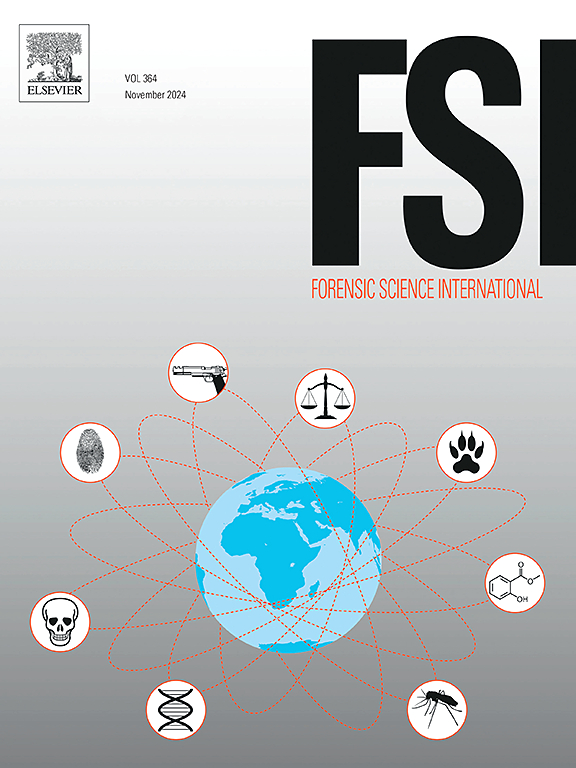重现性和验证的目标和灵活的表观遗传时钟法医应用
IF 2.2
3区 医学
Q1 MEDICINE, LEGAL
引用次数: 0
摘要
DNA甲基化变异体已被广泛用作衰老的生物标志物,并且已经开发了一些数学模型来估计生物年龄。最近,DNA技术引发了对基于阵列的表观遗传时钟的简化和靶向方法的努力,基于对少数CpG位点的评估已经开发出来。在这些时钟中包含的标记中,ELOVL2、FHL2、KLF14、C1orf132/MIR29B2C和TRIM59是验证最强烈的标记。我们测试了先前开发的靶向表观遗传时钟的可重复性和有效性,该时钟专门针对血液样本中的实足年龄测量进行了优化。该时钟包括与实足年龄密切相关的DNAm生物标志物,其DNA甲基化水平是通过使用多重甲基化快照测定来测量的。我们发现,使用开发的时钟计算的表观遗传年龄与年龄高度相关(r = 0.97),共201份血液样本涵盖了整个人类年龄谱。对于其中的74个,通过Infinium methylation EPIC v2.0 Kit获得了全基因组的甲基化谱,该试剂盒也允许估计最常用的Horvath时钟。这些结果表明,我们的高效和负担得起的测试方法可以同时测量多个目标CpG位点的DNA甲基化水平,以评估实足年龄。我们观察到,使用SNaPshot方法测量的分析CpG位点的预测模型与使用Illumina EPIC阵列获得的预测模型之间存在很强的相关性,特别是与专为皮肤和血细胞DNA开发的Horvath2时钟之间。本文章由计算机程序翻译,如有差异,请以英文原文为准。
Reproducibility and validation of a targeted and flexible epigenetic clock for forensic applications
DNA methylation variants have been widely used as biomarkers of ageing and several mathematical models have been developed to estimate the biological age. More recently, DNA technology has triggered efforts toward the simplification of the array-based epigenetic clocks and targeted approaches, based on the assessment of a small number of CpG sites have been developed. Among the markers included in these clocks, ELOVL2, FHL2, KLF14, C1orf132/MIR29B2C, and TRIM59 resulted to be the most strongly validated markers. We tested the reproducibility and validation of a previously developed targeted epigenetic clock purposely optimized for the measurement of chronological age in blood samples. The clock includes DNAm biomarkers strongly correlated with chronological age whose DNA methylation levels were measured by using a multiplex methylation SNaPshot assay. We found that epigenetic age, calculated using the developed clock, was highly correlated with age (r = 0.97) in a total of 201 blood samples covering a full spectrum of human ages. For 74 of these, methylation profiles of the whole genome were obtained through the Infinium Methylation EPIC v2.0 Kit which also allowed to estimate the most frequently used clocks of Horvath. These results show the potential of our efficient and affordable test for simultaneously measuring DNA methylation levels at multiple target CpG sites to assess chronological age. We observed a strong correlation between the prediction models for the analyzed CpG sites measured using the SNaPshot method and those obtained with the Illumina EPIC array, especially with the Horvath2 clock, which was specifically developed for DNA from skin and blood cells.
求助全文
通过发布文献求助,成功后即可免费获取论文全文。
去求助
来源期刊

Forensic science international
医学-医学:法
CiteScore
5.00
自引率
9.10%
发文量
285
审稿时长
49 days
期刊介绍:
Forensic Science International is the flagship journal in the prestigious Forensic Science International family, publishing the most innovative, cutting-edge, and influential contributions across the forensic sciences. Fields include: forensic pathology and histochemistry, chemistry, biochemistry and toxicology, biology, serology, odontology, psychiatry, anthropology, digital forensics, the physical sciences, firearms, and document examination, as well as investigations of value to public health in its broadest sense, and the important marginal area where science and medicine interact with the law.
The journal publishes:
Case Reports
Commentaries
Letters to the Editor
Original Research Papers (Regular Papers)
Rapid Communications
Review Articles
Technical Notes.
 求助内容:
求助内容: 应助结果提醒方式:
应助结果提醒方式:


